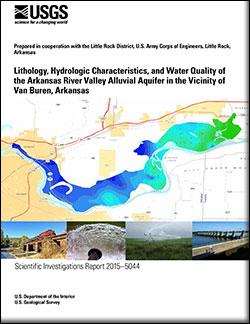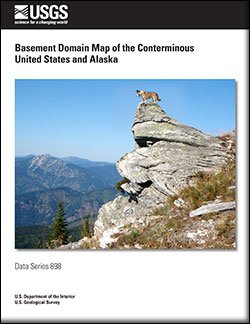Filters: Categories: Publication (X) > partyWithName: U.S. Geological Survey (X)
480 results (25ms)|
Filters
Date Range
Extensions
Types Contacts
Categories Tag Types
|

Categories: Publication;
Types: Citation,
Map Service,
OGC WFS Layer,
OGC WMS Layer,
OGC WMS Service;
Tags: Scientific Investigations Report
Categories: Publication;
Types: Citation
Millions of pounds of mercury (Hg) were deposited in the river and stream channels of the Sierra Nevada from placer and hard-rock mining operations in the late 1800s and early 1900s. The resulting contaminated sediments are relatively harmless when buried and isolated from the overlying aquatic environment. The entrained Hg in the sediment constitutes a potential risk to human and ecosystem health should it be reintroduced to the actively cycling portion of the aquatic system, where it can become methylated and subsequently bioaccumulated in the food web. Each year, sediment is mobilized within these fluvial systems during high stormflows, transporting hundreds of tons of Hg-laden sediment downstream. The State...
Categories: Publication;
Types: Citation
The United States (U.S.) Geological Survey has been working with the Afghanistan Geological Survey and the Afghanistan Ministry of Energy and Water on water-resources investigations in the Kabul Basin under an agreement supported by the United States Agency for International Development. This collaborative investigation compiled, to the extent possible in a war-stricken country, a varied hydrogeologic data set and developed limited data-collection networks to assist with the management of water resources in the Kabul Basin. This report presents the results of a multidisciplinary water-resources assessment conducted between 2005 and 2007 to address questions of future water availability for a growing population and...
Categories: Publication;
Types: Citation
The purpose of the Reston Stable Isotope Laboratory (RSIL) lab code 2900 is to determine the δ15N and δ18O of nitrate (NO3-) in water. The δ15N and δ18O of the dissolved NO3- are analyzed by converting the NO3- to nitrous oxide (N2O), which serves as the analyte for mass spectrometry. A culture of denitrifying bacteria is used in the enzymatic conversion of the NO3- to N2O, which follows the pathway shown in equation 1: NO3- → NO2- → NO → 1/2 N2O (1) Because the bacteria Pseudomonas aureofaciens lack N2O reductive activity, the reaction stops at N2O, unlike the typical denitrification reaction that goes to N2. After several hours, the conversion is complete, and the N2O is extracted from the vial, separated from...
Categories: Publication;
Types: Citation
The purpose of the Reston Stable Isotope Laboratory (RSIL) lab code 1832 is to determine the δ(15N/14N), abbreviated as δ15N, and the δ(13C/12C), abbreviated as δ13C, of total nitrogen and carbon in a solid sample. A Carlo Erba NC 2500 elemental analyzer (EA) is used to convert total nitrogen and carbon in a solid sample into N2 and CO2 gas. The EA is connected to a continuous flow isotope-ratio mass spectrometer (CF-IRMS), which determines the relative difference in stable nitrogen isotope-amount ratio (15N/14N) of the product N2 gas and the relative difference in stable carbon isotope-amount ratio (13C/12C) of the product CO2 gas. The combustion is quantitative; no isotopic fractionation is involved. Samples are...
Categories: Publication;
Types: Citation
The Retsof salt mine in upstate New York was flooded from 1994 to 1996 after two roof collapses created rubble chimneys in overlying bedrock that intersected a confined aquifer in glacial sediments. The mine now contains about 60 billion liters of saturated halite brine that is slowly being displaced as the weight of overlying sediments causes the mine cavity to close, a process that could last several hundred years. Saline water was detected in the confined aquifer in 2002, and a brine-mitigation project that includes pumping followed by onsite desalination was implemented in 2006 to prevent further migration of saline water from the collapse area. A study was conducted by the U.S. Geological Survey using geochemical...
Categories: Publication;
Types: Citation
μThis study of phosphorus (P) cycling in eutrophic Upper Klamath Lake (UKL), Oregon, was conducted by the U.S. Geological Survey in cooperation with the U.S. Bureau of Reclamation. Lakebed sediments from the upper 30 centimeters (cm) of cores collected from 26 sites were characterized. Cores were sampled at 0.5, 1.5, 2.5, 3.5, 4.5, 10, 15, 20, 25, and 30 cm. Prior to freezing, water content and sediment pH were determined. After being freeze-dried, all samples were separated into greater than 63-micron (μm) particle-size (coarse) and less than 63-μm particle-size (fine) fractions. In the surface samples (0.5 to 4.5 cm below the sediment water interface), approximately three-fourths of the particles were larger than...
Categories: Publication;
Types: Citation
This report presents a summary of data collected during April and August 1993 and September 1994. These results are to be used as a wet-site analog to southern Nevada soils located at the Amargosa Desert Research Site near Beatty, Nevada. The samples were collected and analyzed in conjunction with the Nevada Basin and Range study unit of the U.S. Geological Survey, National Water-Quality Assessment Program (NAWQA). Samples were collected from groundwater wells in and about the city of Las Vegas, Nevada, and were analyzed for selected major, minor and trace constituents. Analyses of blank and reference samples are summarized as mean and standard deviation values for all positive results.
Categories: Publication;
Types: Citation
In 1983, a snowmelt energy budget study was initiated by the U.S. Geological Survey on a small watershed near Rabbit Ears Pass, Colorado, to better understand snowmelt processes. The study included data collection from hydrological and meteorological instrumentation. Interest in long term, high-altitude meteorological sites has increased recently due to the increased awareness of global climate change. The meteorological data collected near Rabbit Ears Pass may aid researchers involved in global climate change studies. Meteorological data from 1984 to 2008 are presented.
Categories: Publication;
Types: Citation

Categories: Publication;
Types: Citation,
Map Service,
OGC WFS Layer,
OGC WMS Layer,
OGC WMS Service;
Tags: Data Series
The computer program described in this report, MODPATH-LGR, is designed to allow simulation of particle tracking in locally refined grids. The locally refined grids are simulated by using MODFLOW-LGR, which is based on MODFLOW-2005, the three-dimensional groundwater-flow model published by the U.S. Geological Survey. The documentation includes brief descriptions of the methods used and detailed descriptions of the required input files and how the output files are typically used. The code for this model is available for downloading from the World Wide Web from a U.S. Geological Survey software repository. The repository is accessible from the U.S. Geological Survey Water Resources Information Web page at http://water.usgs.gov/software/ground_water.html....
Categories: Publication;
Types: Citation
Categories: Publication;
Types: Citation
Wells that are open to multiple aquifers can provide preferential pathways to flow and solute transport that short-circuit normal fluid flowlines. Representing these features in a regional flow model can produce a more realistic and reliable simulation model. This report describes modifications to the Multi-Node Well (MNW) Package of the U.S. Geological Survey (USGS) three-dimensional ground-water flow model (MODFLOW). The modifications build on a previous version and add several new features, processes, and input and output options. The input structure of the revised MNW (MNW2) is more well-centered than the original verion of MNW (MNW1) and allows the user to easily define hydraulic characteristics of each multi-node...
Categories: Publication;
Types: Citation
|

|